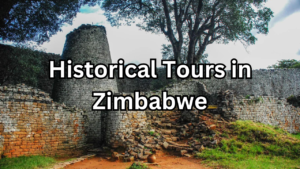
Table of Contents
Introduction
Historical Tours in Namibia, a land of striking landscapes and vibrant cultures, also boasts a rich tapestry of history waiting to be explored through its diverse range of historical tours. From ancient rock art etched into the desert rocks to colonial-era architecture nestled in coastal towns, Namibia’s historical sites offer a compelling narrative of its past. These tours not only showcase the country’s journey from ancient civilizations to colonial rule and independence but also highlight its resilience and cultural diversity. Whether you’re fascinated by the remnants of diamond mining towns frozen in time or intrigued by the stories of struggle and survival during tumultuous periods, Namibia’s historical tours promise an enriching experience that deepens understanding and appreciation of this captivating country. Join us on a journey through Namibia’s history, where each tour unveils layers of the past, shaping the present and inspiring the future.
Brief Overview of Historical Tours in Namibia
Namibia, situated in southwestern Africa, is a land of captivating contrasts and deep historical roots. Its history is shaped by a tapestry of cultures, ancient traditions, and colonial influences that have left an indelible mark on its landscape and people. The country’s rich heritage can be traced back thousands of years through the intricate rock art of the San Bushmen, found in sites like Twyfelfontein, which are testament to early human settlements and spiritual beliefs.
During the colonial era, Namibia was a focal point of European exploration and exploitation, particularly under German and later South African rule. This period introduced architecture, language, and customs that blend with Namibia’s indigenous cultures, creating a unique cultural mosaic that defines its identity today. The struggle for independence, culminating in Namibia’s freedom in 1990, further shapes its modern narrative, symbolizing resilience and determination against colonial oppression.
Importance of Historical Tours in Understanding Namibia’s Past
Historical tours in Namibia play a crucial role in unraveling and preserving the country’s complex history. They provide immersive experiences that bring to life the stories of ancient civilizations, colonial expansion, and the journey towards independence. By visiting sites like Kolmanskop’s ghost town or the preserved German architecture in Swakopmund, visitors gain insights into the economic, social, and environmental impacts of historical events on Namibia’s development.
These tours not only educate but also foster appreciation for Namibia’s cultural diversity and resilience. They highlight the contributions of various communities, such as the Herero and Nama people, whose histories are intricately woven into the fabric of Namibian society. Moreover, understanding Namibia’s past through historical tours promotes cross-cultural understanding and empathy, essential for building a harmonious future in a multicultural society.
In essence, historical tours in Namibia are a gateway to discovering the country’s layered past, offering visitors an opportunity to engage with its history in meaningful ways. They encourage reflection on the complexities of historical narratives and inspire dialogue on issues of identity, heritage preservation, and reconciliation. By exploring Namibia’s historical sites, one embarks on a transformative journey through time, connecting the past with the present and appreciating the enduring spirit of its people.
Windhoek City Tour
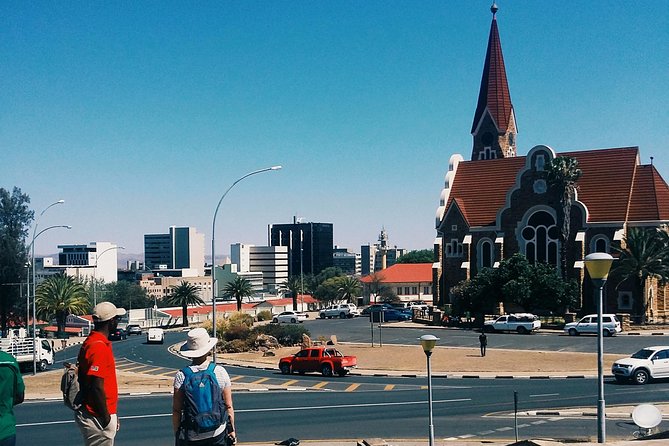
Embark on a journey through Windhoek, the capital city of Namibia, where history and modernity converge amidst a backdrop of colonial architecture and cultural landmarks.
Explore Windhoek’s Colonial Architecture
Windhoek’s skyline is adorned with a blend of colonial-era buildings that reflect its history as a former German colonial outpost. Stroll through Independence Avenue, lined with quaint cafes and shops housed in historical structures, each bearing testament to Namibia’s colonial past. The architecture, characterized by its European influence fused with African motifs, offers a glimpse into the city’s architectural evolution over centuries.
Visit Landmarks like the Alte Feste and Christuskirche
The Alte Feste, or Old Fort, stands as a proud sentinel of Windhoek’s colonial heritage. Originally constructed by Imperial Germany in 1890, it served as a military headquarters and later as a museum chronicling Namibia’s history. Explore its sturdy walls and exhibits that narrate the city’s transformation from a military stronghold to a cultural center.
Nearby, the Christuskirche (Christ Church) stands as an iconic landmark, its distinctive Neo-Gothic spire piercing the sky. Built during the early 20th century, this church is not only a place of worship but also a symbol of Namibia’s architectural prowess under German colonial rule. Step inside to admire its stained glass windows and serene ambiance, resonating with echoes of the past.
Historical Significance of Windhoek as a Colonial Hub
Windhoek holds pivotal importance in Namibia’s colonial history, serving as a strategic center for German administration and commerce. Established as a German settlement in 1890, it rapidly developed into a hub of trade, governance, and cultural exchange. The city’s layout, still visible in its central districts, reflects the systematic planning typical of European colonial towns.
Moreover, Windhoek’s role expanded during subsequent South African rule, further shaping its identity as a cultural crossroads in southern Africa. Today, its bustling streets and diverse populace embody a blend of Namibian and international influences, making it a vibrant city where history unfolds at every corner.
Conclusion
A Windhoek city tour offers more than just a glimpse into the past—it invites visitors to immerse themselves in Namibia’s colonial legacy and dynamic present. From exploring architectural marvels to understanding the city’s strategic importance in historical contexts, Windhoek captivates with its stories of resilience, adaptation, and cultural evolution. Discover Windhoek, where history meets modernity in a tapestry of architectural wonders and cultural landmarks.
Kolmanskop Ghost Town Tour
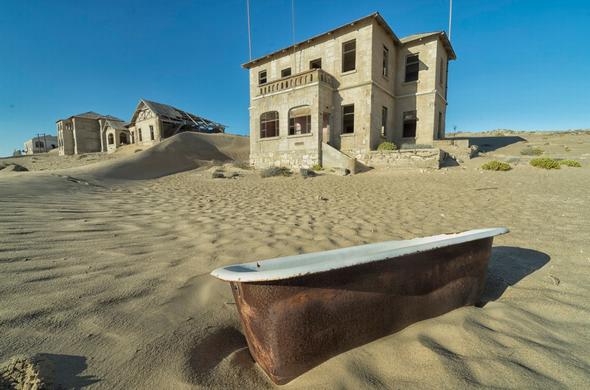
Step back in time and uncover the haunting beauty of Kolmanskop, a ghost town nestled in the Namib Desert near Lüderitz, Namibia’s southern coast.
Discover the Abandoned Diamond Mining Town near Lüderitz
Kolmanskop was once a bustling hub of diamond mining activity during the early 20th century, attracting fortune seekers from around the world. Established in 1908 by German settlers, this town flourished briefly as diamonds were discovered in the surrounding desert sands. Its architecture, influenced by German colonial design, reflects the prosperity and ambition of its heyday.
Today, Kolmanskop stands frozen in time, its sand-swallowed buildings and empty streets offering a poignant glimpse into the past. Wander through dilapidated homes, eerily preserved interiors, and abandoned machinery that evoke a sense of both wonder and melancholy. The desert’s relentless march has reclaimed much of Kolmanskop, creating a surreal landscape where nature and human history intertwine.
Historical Context of Diamond Mining in Namibia
Diamond mining played a crucial role in Namibia’s colonial and economic history, shaping its development and infrastructure. The discovery of diamonds in areas like Kolmanskop fueled rapid urbanization and economic growth, attracting laborers and entrepreneurs seeking wealth. This period of mining prosperity left an enduring legacy on Namibia’s economy and social fabric, influencing its trajectory towards independence and beyond.
Preservation Efforts and Current State of Kolmanskop
In recent years, efforts have been made to preserve and protect Kolmanskop’s historical significance. Guided tours offer visitors a chance to explore its evocative ruins while learning about the town’s rise and fall. Conservation initiatives aim to stabilize and maintain key structures, ensuring that future generations can experience this unique slice of Namibian history.
Despite the encroaching desert sands, Kolmanskop continues to captivate and inspire, serving as a poignant reminder of Namibia’s mining heritage and the transient nature of human endeavor. Its allure lies not only in its abandoned grandeur but also in the stories it tells of ambition, fortune, and the relentless march of time.
Conclusion
A journey to Kolmanskop is a journey into Namibia’s past, where the echoes of diamond fever and colonial ambition resonate through its sun-bleached ruins. It invites reflection on the interplay between human industry and nature’s resilience, offering a profound and unforgettable exploration of history in the heart of the Namib Desert.
Swakopmund Walking Tour
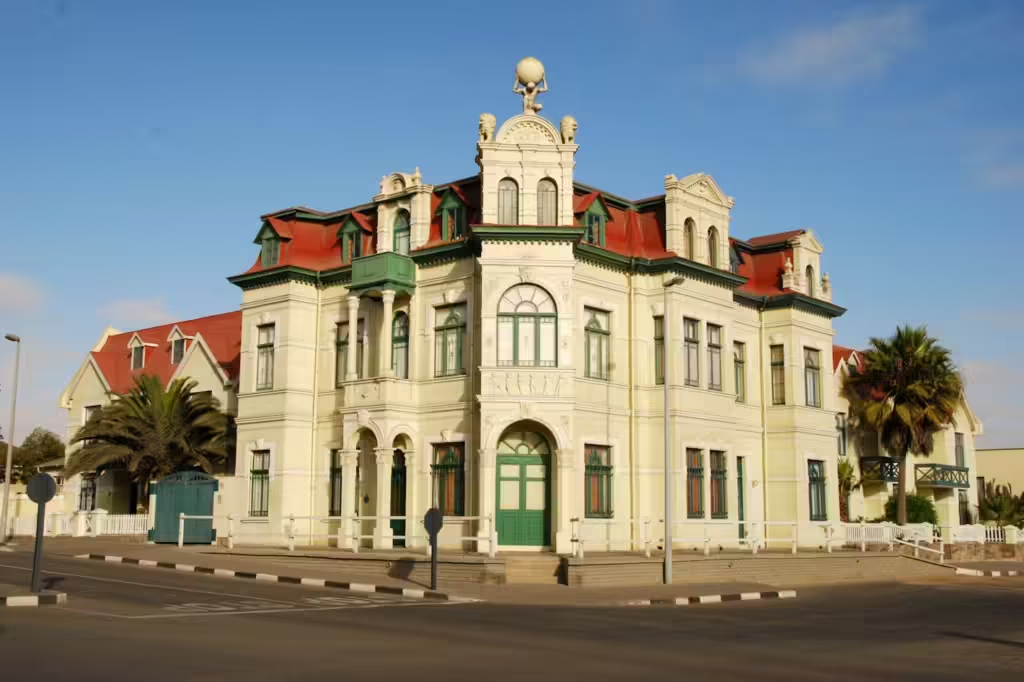
Immerse yourself in the charming coastal town of Swakopmund, where German colonial architecture and vibrant cultural heritage create a captivating tapestry of Namibian history.
German Colonial Influences in Swakopmund
Founded in 1892 during German colonial rule, Swakopmund served as a vital port and gateway to the Namib Desert hinterland. Its layout and architecture bear distinct German influences, evident in the ornate facades, gabled roofs, and timber-framed buildings that line its streets. The town’s planning reflects German precision and efficiency, designed to withstand the harsh desert climate while maintaining a European aesthetic.
Historic Buildings and Museums Showcasing Colonial Architecture
A stroll through Swakopmund reveals a wealth of colonial-era buildings that have been meticulously preserved and restored. Visit landmarks such as the Hohenzollernhaus, a majestic building housing the Swakopmund Museum, where exhibits delve into Namibia’s natural history, cultural heritage, and colonial past. The Woermannhaus, once a trading post, now hosts cultural events and exhibits that illuminate Swakopmund’s role in Namibia’s history.
Cultural and Historical Significance of Swakopmund
Swakopmund stands as a testament to Namibia’s colonial history and its enduring cultural legacy. Beyond its architectural splendor, the town is a melting pot of cultures, blending indigenous traditions with European influences brought by settlers and traders. Its strategic location facilitated trade and communication, shaping Namibia’s economic development and cultural exchange.
Today, Swakopmund remains a popular destination for travelers seeking to explore Namibia’s past and enjoy its scenic beauty. The town’s pristine beaches, vibrant markets, and outdoor activities complement its historical attractions, offering visitors a multifaceted experience that celebrates both its colonial heritage and natural wonders.
Conclusion
A Swakopmund walking tour offers a captivating journey through Namibia’s colonial past and cultural diversity. From its German-inspired architecture to its rich history and scenic landscapes, Swakopmund invites exploration and reflection on the intersection of European colonialism and African resilience. Discover the charm of Swakopmund, where history meets the present in a harmonious blend of architectural elegance and cultural vibrancy.
Twyfelfontein Rock Art Tour
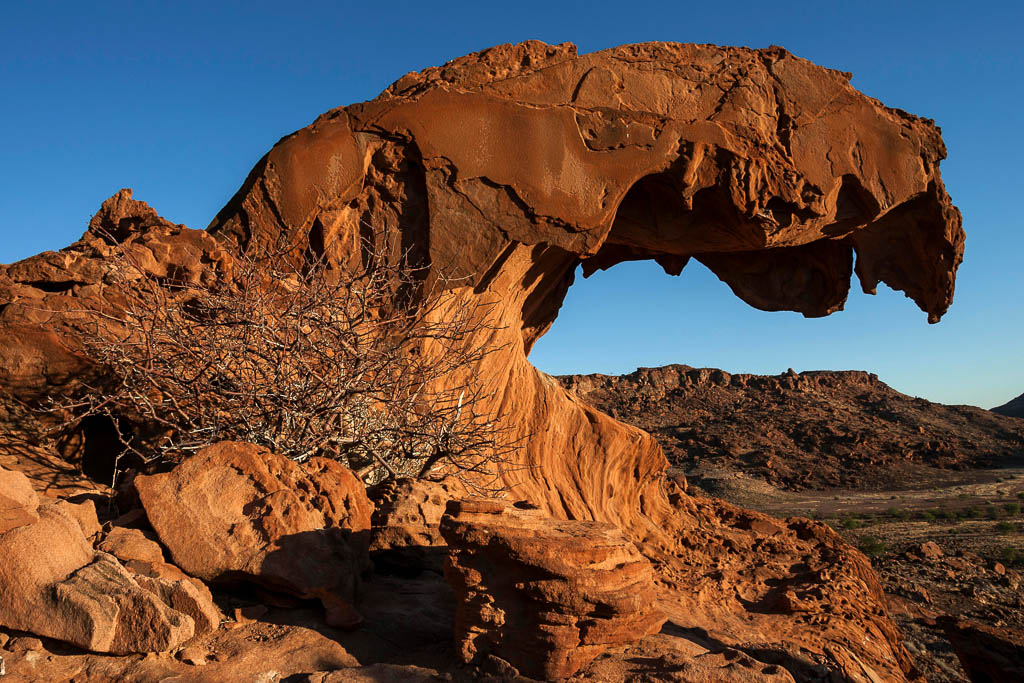
Explore Ancient San Bushmen Engravings
Twyfelfontein is renowned for its extensive collection of rock engravings, crafted by the San Bushmen over thousands of years. These intricate carvings depict a rich tapestry of ancient life, capturing scenes of hunting, ritual dances, and spiritual beliefs. Wander through the rocky outcrops adorned with these petroglyphs, marveling at the skill and artistry of Namibia’s earliest inhabitants.
Significance of Twyfelfontein as a UNESCO World Heritage Site
Designated a UNESCO World Heritage site in 2007, Twyfelfontein holds global significance for its cultural and archaeological value. It stands as a testament to the San Bushmen’s cultural heritage and their deep connection to the land. The site’s preservation ensures that future generations can appreciate and study these ancient artworks, providing insights into the region’s prehistoric past and the evolution of human creativity.
Interpretation of Rock Art and Its Cultural Importance
The rock art at Twyfelfontein offers a window into the spiritual and cultural practices of the San Bushmen, who used these engravings to communicate with ancestors, record historical events, and express their worldview. Each motif and symbol carries layers of meaning, reflecting a symbiotic relationship between humans and nature that has persisted for millennia.
Understanding the cultural importance of Twyfelfontein’s rock art fosters appreciation for indigenous knowledge and traditions. It underscores the importance of preserving cultural heritage amidst modernization and development pressures, highlighting the resilience of Namibia’s indigenous peoples and their enduring contributions to global heritage.
Conclusion
A Twyfelfontein rock art tour promises a profound journey into Namibia’s ancient past, where the echoes of the San Bushmen resonate through time. It invites reflection on humanity’s artistic ingenuity, cultural diversity, and the interconnectedness of people with their environment. Discover Twyfelfontein, where rock art tells stories of survival, spirituality, and the enduring legacy of Namibia’s indigenous peoples.
Cape Cross Seal Reserve
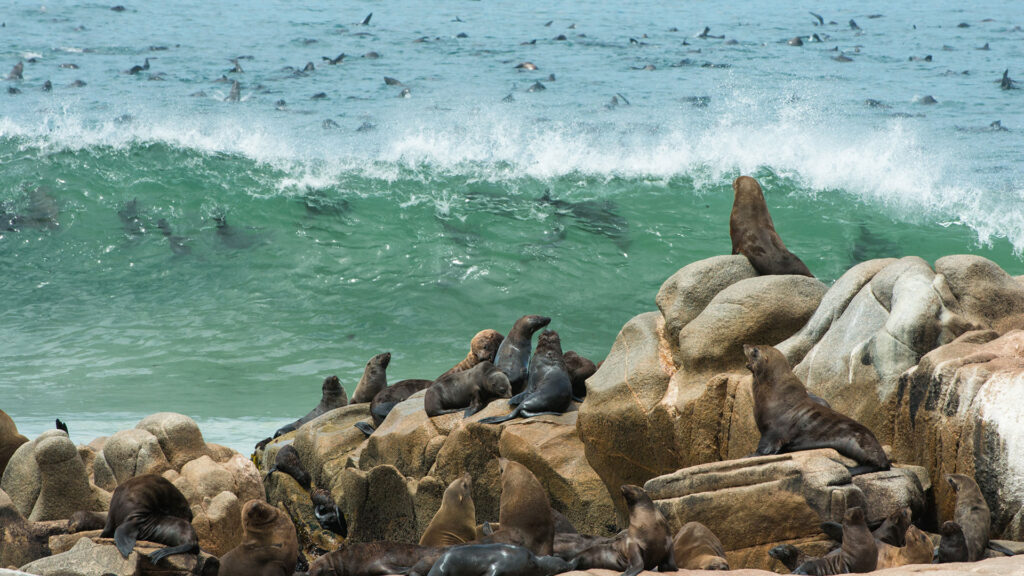
Embark on a journey to Cape Cross Seal Reserve, where history, wildlife, and natural beauty converge on Namibia’s rugged Atlantic coastline.
History of Portuguese Explorer Diego Cão’s Landing
Cape Cross holds historical significance as the site where Portuguese explorer Diego Cão landed in 1486 during his expedition along the African coast. Cão erected a stone cross to mark his journey, symbolizing Portugal’s maritime exploration and early interactions with African cultures. This landmark stands as one of the earliest European monuments in sub-Saharan Africa, representing a pivotal moment in global maritime history.
Significance of the Cross and Early European Interactions in Namibia
The cross at Cape Cross serves as a tangible reminder of early European exploration and colonization efforts in southern Africa. It symbolizes the intersection of European ambitions for trade, expansion, and missionary activities with indigenous communities along the Namibian coast. The legacy of these interactions continues to shape Namibia’s cultural landscape and historical narrative, reflecting both cooperation and conflict between different worldviews and civilizations.
Wildlife and Conservation Efforts at Cape Cross
Beyond its historical importance, Cape Cross is renowned for its abundant wildlife, particularly the Cape fur seals. The reserve hosts one of the largest colonies of these marine mammals in the world, with thousands congregating along the rocky shoreline. Visitors can observe seals in their natural habitat, witnessing their playful antics and interactions within the colony.
Conservation efforts at Cape Cross focus on protecting the fragile marine ecosystem and maintaining sustainable tourism practices. Educational programs and guided tours offer insights into seal behavior, coastal ecology, and conservation challenges facing these iconic creatures. By promoting responsible tourism, Cape Cross ensures that future generations can experience and appreciate Namibia’s rich biodiversity and historical heritage.
Conclusion
A visit to Cape Cross Seal Reserve promises a journey through history and nature, where the echoes of Diego Cão’s expedition resonate alongside the calls of seals on the rocky shores. It invites reflection on the complexities of early European exploration, the resilience of wildlife in challenging environments, and the importance of conservation in safeguarding Namibia’s coastal treasures. Discover Cape Cross, where past and present converge in a breathtaking coastal sanctuary teeming with life and history.
Namib-Naukluft Park

Explore the vast expanse of Namib-Naukluft Park, a sanctuary of geological wonders and cultural significance nestled in the heart of Namibia’s arid landscape.
Geological History of the Namib Desert
Namib-Naukluft Park showcases the geological evolution of the Namib Desert, believed to be the oldest desert in the world. Over millions of years, geological forces have sculpted towering dunes, expansive gravel plains, and rugged mountainscapes. The desert’s unique red sands, formed from iron oxide deposits, create a surreal contrast against the deep blue skies, offering photographers and nature enthusiasts a mesmerizing vista unlike any other.
Visit to Sossusvlei and Deadvlei Dunes
Sossusvlei and Deadvlei are iconic destinations within Namib-Naukluft Park, renowned for their striking dune formations and stark landscapes. Sossusvlei, a salt and clay pan surrounded by towering red dunes, stands as a testament to the desert’s dynamic nature. Visitors can climb the towering Dune 45 for panoramic views or venture into Deadvlei, where ancient camel thorn trees stand frozen in time amidst a white clay pan, contrasting with the surrounding dunes.
Cultural Significance of the Desert Landscape
The desert landscape of Namib-Naukluft Park holds profound cultural significance for Namibia’s indigenous communities, such as the Nama and San peoples. It serves as a repository of traditional knowledge and spiritual beliefs, where natural landmarks and celestial phenomena are intertwined with ancestral stories and rituals. The desert’s vastness and harsh beauty inspire a deep respect for nature and a connection to the land that has sustained generations of Namibians.
Visiting Namib-Naukluft Park offers more than a glimpse into geological history—it invites travelers to experience the cultural richness and resilience of Namibia’s desert communities. The park’s conservation efforts ensure that this fragile ecosystem and its cultural heritage are preserved for future generations to explore and appreciate.
Conclusion
Namib-Naukluft Park is a testament to the enduring forces of nature and the cultural vitality of Namibia’s desert landscapes. It beckons adventurers to discover its geological marvels, from towering dunes to ancient pans, while honoring the cultural traditions that have shaped this desert realm. Explore Namib-Naukluft Park, where the sands of time reveal stories of resilience, adaptation, and the timeless beauty of the Namib Desert.
Etosha National Park

Journey into the heart of wildlife and history at Etosha National Park, a sanctuary of natural wonders and cultural significance in northern Namibia.
Historical Waterholes and Ancient Settlements
Etosha National Park is renowned for its network of natural and artificial waterholes, which have sustained wildlife and human settlements for centuries. These water sources served as vital lifelines for ancient inhabitants, including San Bushmen and later pastoralist communities. The remnants of stone tools and rock engravings found within the park bear testament to their enduring presence and adaptation to the harsh desert environment.
Wildlife Conservation and Historical Ecology
Etosha’s ecological diversity and abundance of wildlife are testament to its role as one of Africa’s premier wildlife conservation areas. The park is home to an impressive array of species, including elephants, lions, rhinos, and endemic bird species, all thriving within its unique ecosystems. Conservation efforts aim to protect these habitats and their inhabitants, ensuring the park’s ecological integrity for future generations.
Historically, Etosha’s ecological balance and seasonal migrations have shaped the lives of indigenous communities and influenced their cultural practices. The park’s landscapes and wildlife continue to inspire reverence and respect among Namibians, reflecting a deep-seated connection to the land and its natural resources.
Significance of Etosha in Namibian History and Culture
Etosha National Park holds profound significance in Namibian history and culture, symbolizing the country’s commitment to wildlife conservation and environmental stewardship. Its establishment as a national park in 1907 marked a pivotal moment in the preservation of Namibia’s natural heritage, safeguarding vast tracts of wilderness and promoting sustainable tourism practices.
Culturally, Etosha embodies the spiritual and ecological interconnectedness cherished by Namibia’s diverse communities. Traditional beliefs and rituals often center around wildlife and natural phenomena, highlighting the park’s role as a living repository of cultural traditions and ancestral knowledge.
Conclusion
Etosha National Park is more than a wildlife sanctuary—it is a testament to Namibia’s conservation legacy and cultural resilience. By exploring its historical waterholes, diverse ecosystems, and cultural significance, visitors gain a deeper appreciation for the interconnectedness of nature and human history in this remarkable corner of Africa. Discover Etosha, where wildlife thrives, history unfolds, and cultural traditions endure amidst the vast plains and shimmering salt pans of northern Namibia.
Waterberg Plateau Park
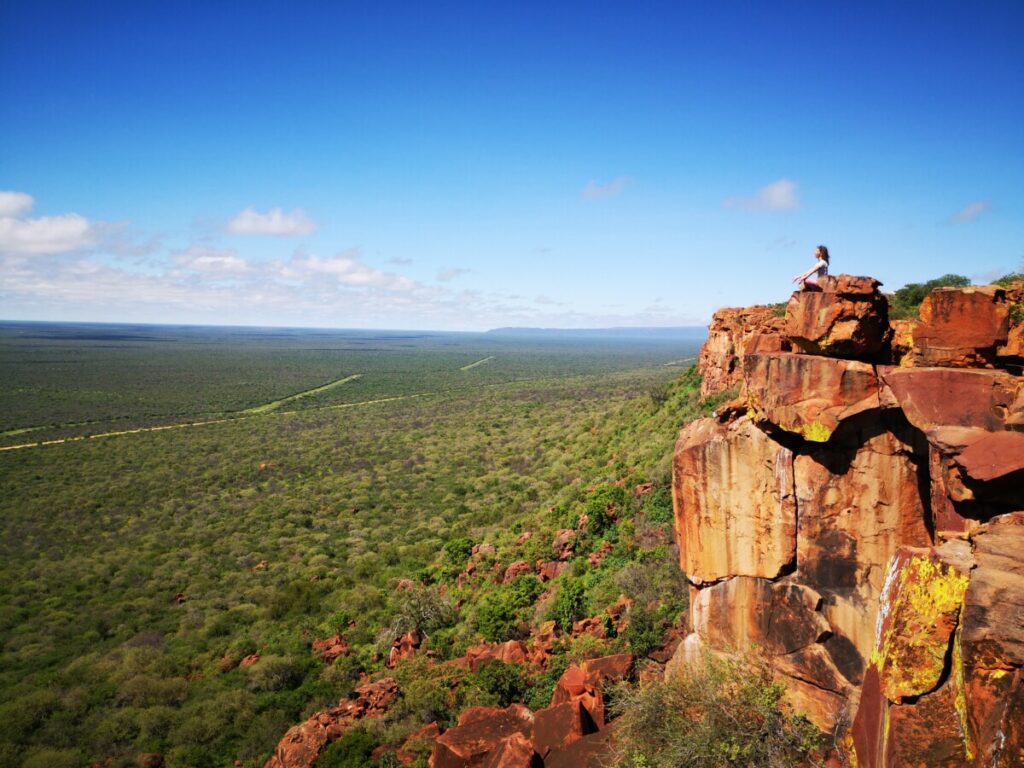
Delve into the rich history and natural beauty of Waterberg Plateau Park, a sanctuary of biodiversity and cultural significance in central Namibia.
Battle of Waterberg and Its Historical Context
Waterberg Plateau holds historical significance as the site of the Battle of Waterberg in 1904, a pivotal conflict during the Herero and Namaqua genocide. The plateau’s strategic location provided a natural fortress for German forces, leading to a decisive victory that profoundly impacted Namibia’s colonial history. The battle remains a poignant reminder of the struggles faced by Namibia’s indigenous peoples against colonial oppression and serves as a memorial to those who lost their lives.
Conservation Efforts and Biodiversity of the Area
Today, Waterberg Plateau Park is renowned for its diverse ecosystems and conservation efforts. The park’s towering sandstone cliffs and lush valleys support a wealth of flora and fauna, including rare species such as the endemic sable antelope and Cape vulture. Conservation initiatives focus on preserving these habitats and promoting sustainable tourism practices, ensuring the park’s ecological integrity and biodiversity for future generations to enjoy.
Cultural Significance of the Waterberg Plateau
Waterberg Plateau holds profound cultural significance for Namibia’s indigenous communities, particularly the Herero and San peoples. The plateau’s natural springs and fertile valleys have long sustained human settlements, providing a haven for pastoralists and hunter-gatherers alike. The area’s cultural heritage is reflected in traditional beliefs, oral histories, and rituals that honor the land’s spiritual importance and the resilience of its inhabitants.
Visiting Waterberg Plateau Park offers more than a glimpse into its natural beauty—it provides an opportunity to connect with Namibia’s cultural heritage and reflect on the complexities of its history. The park’s serene landscapes and historical landmarks invite visitors to explore, learn, and appreciate the interplay between nature and human experience in this captivating corner of Namibia.
Conclusion
Waterberg Plateau Park is a testament to Namibia’s natural and cultural diversity, offering a window into its turbulent history and enduring traditions. By exploring its historical sites, diverse ecosystems, and cultural significance, visitors gain a deeper appreciation for the interconnectedness of nature, history, and culture in this remarkable landscape. Discover Waterberg Plateau Park, where history echoes through the cliffs, wildlife thrives, and cultural heritage endures amidst the tranquil beauty of central Namibia.
Owela Museum
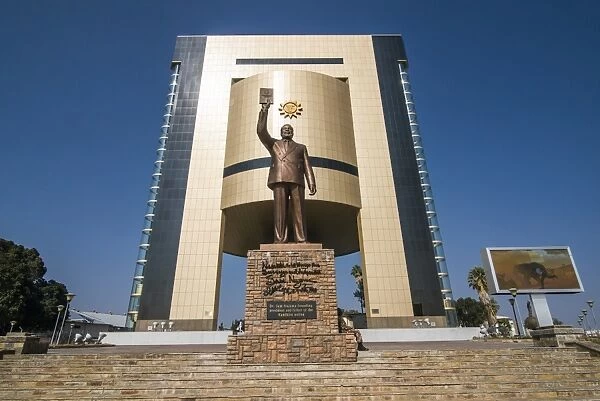
Discover the essence of Namibia’s rich history and cultural heritage at Owela Museum, a hub of knowledge and preservation in Windhoek.
Exhibits Showcasing Namibia’s History and Culture
Owela Museum houses a diverse array of exhibits that chronicle Namibia’s multifaceted history and cultural tapestry. From ancient rock art and artifacts of early human civilizations to colonial-era relics and contemporary artworks, the museum offers a comprehensive journey through the country’s past. Visitors can explore displays on traditional lifestyles, historical events, and the diverse ethnic groups that shape Namibia’s identity today.
Role of Owela Museum in Preserving Namibian Heritage
As a custodian of Namibian heritage, Owela Museum plays a pivotal role in safeguarding and interpreting the nation’s cultural legacy. Through meticulous curation and conservation efforts, the museum preserves artifacts and archives that embody Namibia’s cultural diversity and historical milestones. By documenting and showcasing these treasures, Owela Museum ensures that future generations can appreciate and learn from Namibia’s rich heritage.
Educational Programs and Community Outreach
Owela Museum is committed to fostering educational opportunities and community engagement. It offers a range of educational programs, workshops, and guided tours designed to enhance public understanding of Namibia’s history, culture, and natural environment. These initiatives cater to learners of all ages, promoting lifelong learning and cultural awareness among visitors and local communities alike.
Community outreach initiatives extend Owela Museum’s impact beyond its walls, collaborating with schools, universities, and cultural organizations to promote heritage preservation and historical literacy. By actively engaging with the community, the museum contributes to a deeper appreciation of Namibia’s diverse heritage and encourages dialogue on the importance of cultural stewardship.
Conclusion
Owela Museum stands as a beacon of Namibia’s past, present, and future, offering a gateway to explore the country’s vibrant history and cultural richness. Through its exhibits, preservation efforts, and educational initiatives, the museum inspires a sense of pride in Namibian heritage and fosters a deeper understanding of the forces that have shaped the nation. Visit Owela Museum to embark on a journey through time and culture, where each exhibit tells a story of resilience, creativity, and the enduring spirit of Namibia.
Herero and Namaqua Genocide
Explore a poignant chapter in Namibia’s history marked by tragedy, resilience, and the pursuit of reconciliation.
Historical Background and Context of the Genocide
The Herero and Namaqua genocide, perpetrated by German colonial forces between 1904 and 1908, stands as one of the darkest chapters in Namibia’s history. Triggered by resistance against German colonization and exploitation, the genocide resulted in the deaths of thousands of Herero and Nama people through forced labor, internment in concentration camps, and systematic extermination. The brutality inflicted during this period left a deep scar on Namibia’s cultural fabric and collective memory.
Memorial Sites and Monuments
Namibia commemorates the victims of the genocide through various memorial sites and monuments scattered across the country. The most notable is the Heroes’ Acre near Windhoek, where a mass grave honors those who perished. Additionally, places like the Shark Island concentration camp near Lüderitz serve as somber reminders of the atrocities committed, preserving the memory of the victims and bearing witness to their suffering.
Reflection on Namibia’s Path to Reconciliation and Remembrance
In recent decades, Namibia has made significant strides towards reconciliation and remembrance of the genocide. Official apologies and acknowledgments of Germany’s role in the atrocities have paved the way for dialogue and healing between the affected communities and the Namibian government. Memorials, educational initiatives, and cultural projects aim to raise awareness about the genocide’s impact and promote intercultural understanding among Namibians.
Efforts to seek reparations and repatriate human remains from Germany underscore Namibia’s commitment to justice and historical accountability. The ongoing pursuit of truth and reconciliation continues to shape Namibia’s national narrative, fostering resilience, unity, and a shared commitment to ensuring that such atrocities are never repeated.
Conclusion
The Herero and Namaqua genocide remains a poignant reminder of Namibia’s turbulent past and the enduring quest for justice and reconciliation. Through memorialization, education, and national dialogue, Namibia honors the memory of the victims while striving to build a future founded on mutual respect, understanding, and cultural harmony. Reflect on Namibia’s journey towards remembrance and reconciliation, where the resilience of its people shines as a beacon of hope amidst the shadows of history.
Conclusion
In conclusion, Namibia’s historical and cultural landscapes offer a profound tapestry of experiences, from ancient rock art in Twyfelfontein to the haunting beauty of Kolmanskop’s ghost town. Each site, whether it’s the colonial architecture of Windhoek or the natural wonders of Etosha National Park, tells a story of resilience, adaptation, and the enduring spirit of its people.
Exploring Namibia’s historical tours reveals not only the country’s rich past but also its ongoing journey of reconciliation and preservation. From the solemn memorials of the Herero and Namaqua genocide to the vibrant cultural heritage celebrated at Owela Museum, Namibia invites visitors to engage with its history in meaningful ways. By understanding and appreciating these narratives, we not only honor the past but also contribute to a future where diversity, heritage, and unity thrive.
Whether you’re captivated by the ancient mysteries of rock engravings or drawn to the solemnity of historical battlefields, Namibia offers a profound journey through time and culture. It’s a place where history is alive in every landscape and where the echoes of the past resonate with the promise of a vibrant and inclusive future.
Summary of Diverse Historical Tours in Namibia
Namibia offers a captivating array of historical tours that showcase its rich tapestry of cultures, landscapes, and narratives:
- Windhoek City Tour: Explore colonial-era architecture and landmarks that highlight Namibia’s German and South African colonial history.
- Kolmanskop Ghost Town Tour: Discover the abandoned diamond mining town near Lüderitz, a testament to Namibia’s diamond rush era and subsequent decline.
- Swakopmund Walking Tour: Immerse yourself in German colonial influences amidst coastal landscapes, exploring historic buildings and cultural landmarks.
- Twyfelfontein Rock Art Tour: Journey into ancient times through San Bushmen engravings, exploring the cultural and spiritual significance of this UNESCO World Heritage site.
- Cape Cross Seal Reserve: Visit the site where Portuguese explorer Diego Cão landed, exploring historical markers and observing the abundant wildlife, especially Cape fur seals.
- Namib-Naukluft Park: Witness the geological wonders of the world’s oldest desert, with visits to iconic dunes like Sossusvlei and Deadvlei, and ponder the cultural significance of the desert landscape.
- Etosha National Park: Delve into wildlife conservation and historical waterholes, appreciating the park’s ecological diversity and its cultural significance to Namibia’s indigenous communities.
- Waterberg Plateau Park: Reflect on the Battle of Waterberg, explore diverse ecosystems, and appreciate the park’s cultural significance for Namibia’s indigenous peoples.
- Owela Museum: Engage with exhibits that showcase Namibia’s history and cultural heritage, and understand the museum’s role in preserving and promoting Namibian identity.
- Herero and Namaqua Genocide Sites: Reflect on the tragic history of genocide and visit memorial sites that honor the victims, fostering remembrance and reconciliation in Namibia.
Importance of Preserving and Understanding Namibia’s History
Preserving Namibia’s history is crucial for several reasons:
- Cultural Identity: History forms the bedrock of cultural identity, helping Namibians connect with their heritage and traditions.
- Education and Awareness: Understanding history fosters education and awareness among locals and visitors alike, promoting empathy, tolerance, and mutual respect.
- Tourism and Economy: Historical sites attract tourists, contributing to local economies while raising global awareness of Namibia’s diverse history and culture.
- Reconciliation and Healing: Acknowledging and understanding past injustices, such as the Herero and Namaqua genocide, promotes healing and reconciliation among affected communities.
Recommendations for Travelers Interested in Historical Exploration in Namibia
- Research: Prior to your trip, research Namibia’s history to better appreciate the significance of the sites you’ll visit.
- Guided Tours: Consider joining guided tours led by knowledgeable local guides who can provide context and insights into Namibia’s history.
- Respect and Sensitivity: Show respect at memorial sites and sensitive historical locations. Follow local guidelines and customs.
- Engage with Communities: Take the opportunity to interact with local communities to gain deeper cultural insights and support sustainable tourism practices.
- Support Conservation Efforts: Many historical sites are also natural reserves. Support conservation efforts by following designated trails and respecting wildlife.
Exploring Namibia’s historical tours offers a profound journey through time and culture, where each site tells a story of resilience, adaptation, and the enduring spirit of its people.

